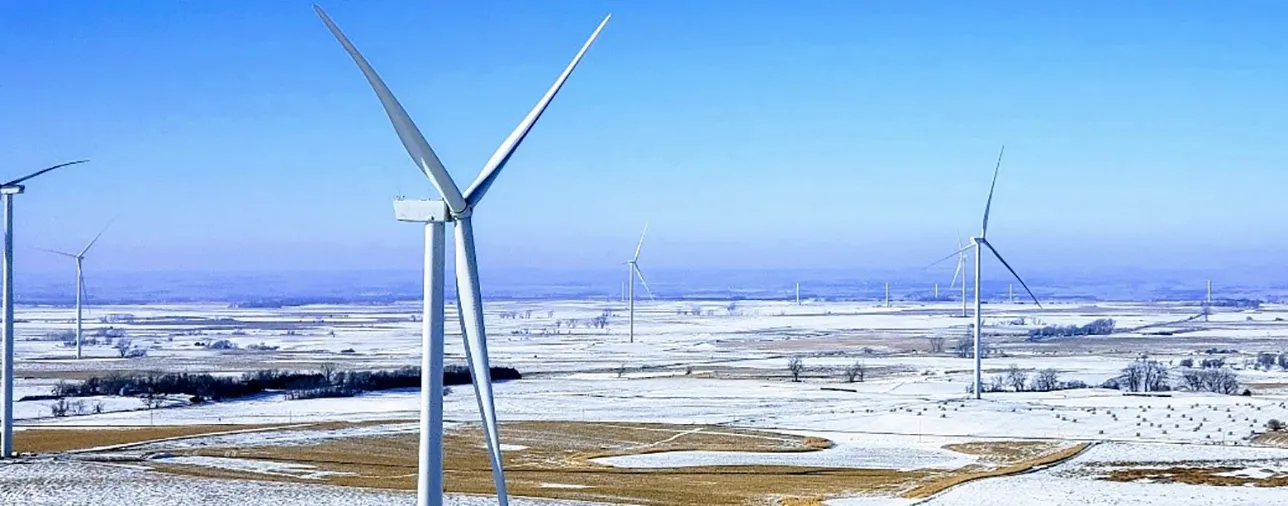Icing and operations in cold temperatures are two important challenges faced by wind farm operators, but there are solutions for existing and future projects!
This post is a companion to two others that covered a summary of the February 2021 weather event in Texas, and the financial impacts on wind projects.
The event and its impact on power production from wind & natural gas
Between the 13th and 19th of February 2021, a cold snap stretched over large parts of Texas. A sudden stratospheric warming event displaced the jet stream and in turn drove Artic air to lower latitudes. Although not record-breaking, regional temperatures were the lowest in the last 30 years. Departures from normal temperatures by up to 25°C (45°F) were recorded, with a low of -10°C (14°F) in Dallas and Houston. While the cold ambient temperatures and the duration of the event were anticipated more than ten days in advance, it led to major disruptions, affecting millions of electricity consumers in Texas.
The Electric Reliability Council of Texas (ERCOT), which oversees approximately 90% of the state’s electric load, reported a maximum outage of over 51 GW. Initial investigations found that various types of energy sources underperformed, including winds farms and natural gas plants. A key problem appears to have been the roughly 26 GW of lost power generating capacity from natural gas-fueled plants, which is about 50% of the state’s installed natural gas power generation capacity. And while only approximately 57% of the installed wind power capacity was available for a period of time, wind is also not consistently expected to be available at full capacity. In ERCOT’s winter 2020/21 capacity forecast , ERCOT specified that on average, wind power is only expected to be available at about 25% of its total installed capacity. As illustrated in Figure 1, comparing the day ahead wind production forecast with the actual wind production shows that the unexpected loss of wind power during the event peaked at approximately 4 GW. So, wind under-delivered compared to expectations, but this under-delivery was small relative to under-delivery from gas-fired production.
Figure 1: ERCOT wind power production during cold snap (Source: ERCOT)
Knowing that wind turbines operate well in Canada, Northern Europe and the Northern U.S., in locations where temperatures of -30°C (-22°F) are not uncommon, it is definitely possible to operate turbines in cold climates. So, why is it that some of the Texas turbines remained available while others were shut down?
Should Texas wind turbines be winterized and what does that mean?
Wind power production often peaks in the winter, when average wind speeds tend to be higher, and air density is high because it is colder. Based on the shift in air density alone, an increased energy potential of more than 15% results from a temperature drop from +20°C to -20°C (68°F to -4°F). However, cold weather comes with challenges and risks for wind power projects. The main technical challenges for wind turbines to operate successfully in cold climates can be categorized into two aspects: low temperatures and icing. While a site can be affected by both, and one may influence the other, they should be considered separately as they typically occur in different conditions: icing occurs around freezing point while low temperature operations may become an issue below -10°C (14°F).
Impacts of low temperatures on turbine operations
Low temperatures impact the functionality of electrical as well as mechanical components. As defined by the IEC61400-1 standard on wind turbines, “standard weather” units operate within ambient temperatures of -10°C to +40°C (14°F to 104°F). Traditionally, most turbine suppliers offered standard weather version turbines based on this IEC temperature range, and offered optional cold weather packages for operations at sites with lower expected temperatures (operations down to -30°C or -40°C (-22°F to -40°F).
That said, over the last five years, more and more turbines are offered with extended temperature packages as their “standard” offering, with operational ranges of -15°C to +40°C, or even -20°C to +40°C. These temperature ranges are based on the technical specifications of the components within the turbine, and are determined to ensure reliable operation and prevent damage.
In order to meet the desired temperature range for the cold climate versions, major components may need to be adapted, such as the material composition of steel towers or cast parts (main frame, hub). Additional heaters may be installed on electrical components, such as transformers, sliprings, electrical cabinets and major mechanical components such as gearboxes. Typical adaptations can also include cold climate seals and lubricants such as grease and oil. In some cases, the nacelle envelope (shell) can be insulated with foam, keeping more heat inside. For safe operation during potentially very cold or icy conditions, the wind measurement instruments (cup anemometer and wind vane) may be replaced with a heated ultrasonic anemometer. Lastly, the wind turbine control system needs to be adapted for the extended temperature range to enable appropriate re-start procedures after extended cold periods. The restart protocol must account for the components’ temperatures, as operating a turbine with cold components may lead to significant damage; it is therefore required to perform a gradual ramp-up to full capacity. The second technical challenge: blade icing Ice formation on blades is a significant challenge, both in terms of aerodynamic efficiency and loads. The icing potential of a site is significantly more difficult to predict than cold temperatures. Mainly two types of icing affect wind turbines: precipitation icing (or freezing rain), resulting from snow or rain freezing shortly after surface contact, and in-cloud icing, which occurs when the turbine’s blades pass through clouds or fog in cold temperatures, in which case supercooled liquid water droplets freeze on the surface upon impact. In both cases, blade icing is most likely to occur at temperatures near freezing (between +3°C and -10°C, or 37°F and 14°F).
Figure 2: Rotor blade icing along the leading edge
Figure 3: In-cloud icing
Icing will primarily occur on the leading edge of a rotor blade and thus change its highly sensitive aerodynamic profile, leading to lower aerodynamic efficiency. Icing also increases the blade’s surface roughness, which impacts air flow around the blade, resulting in turbulence and potentially stall effects. If the blades continue to accumulate ice, two additional risks come into play:
- Ice-throw: Chunks of ice may start to fall off, resulting in a safety concern from falling ice
- Uneven ice accumulation across the turbine’s blades may lead to a rotor unbalance that could eventually be damaging for the turbine.
With ice accumulation, it becomes the designer’s “choice” to what extent the turbine can be allowed to operate with an unbalanced rotor (increasing fatigue loads on the machine), versus the decision to stop the turbine (leading to downtime). Modern turbine controls are capable of identifying icing conditions and may adapt, to some extent, the operational parameters to minimize unfavourable load effects, while attempting to maximize production. That said, severe ice accumulation typically results in turbine shutdown.
De-icing and anti-icing systems
Severe icing events lead to wind turbine shutdowns, which might not have significant impacts if those events are rare and are followed by warm days that rapidly melt the ice. However, a similar icing event occurring at the start of winter and followed by weeks below the freezing point may lead to prolonged periods of downtime as the ice may simply stay on the blades. As such, an icing assessment is extremely important and for severely impacted sites it is generally recommended to include an optional de-icing or anti-icing system to the wind turbines.
Turbine suppliers and third parties offer technical solutions to prevent and/or mitigate ice accumulation. Such systems can generally be purchased as an option, and may be available both for standard weather and cold weather turbines. The two most common technologies are hot air de-icing and electrothermal concepts.
A hot air de-icing system consists of a fan and heater located inside each blade root, blowing hot air inside the blade’s leading edge, providing sufficient warmth to heat the outer blade surface to above the freezing point. Such systems require an appropriate support structure in the blade root to install the heater and an internal structure that allows appropriate air circulation within the blade. As such, while not impossible, it is generally challenging to retrofit an existing blade with this system.
The electrothermal concept is based on heating elements integrated inside the fiberglass of the blade shell, comparable to electrical resistance heating systems used on car rear windows. These are most commonly built into blades at manufacture, as efforts to retrofit an existing blade requires a “heating mesh” to be installed within the blade shell, under the gelcoat. These systems also introduce electrical conducting elements along the blade length, which creates an additional challenge for the design of the lightning protection system of the blades.
Both systems have been used successfully in the industry and can be used in preventive and/or reactive manner. Ice prevention or “anti-icing” is the proactive activation of the blade heating system as soon as icing is detected, allowing continued operation (at slightly reduced energy output due to the system’s energy consumption, potentially on the order of 3-6% of rated power). If icing conditions are light to moderate, these systems can prevent significant ice accumulation and keep the turbine from shutting down due to icing. If the icing event is severe and ice accumulation cannot be prevented, the turbine will shut down to de-ice the blades before restarting.
A de-icing system, on the other hand, requires stopping the turbine before activating the blade heating system. While requiring to shutdown at times, the de-icing system is expected to enable the turbine to restart production rapidly after successful de-icing. Typically, limitations to the amount of electric power than can be brought to the hub and blades, or challenges associated with circulating air inside a long, narrow blade while the rotor is in motion, may explain the choice of using a de-icing system rather than an anti-icing system.
De-icing and anti-icing systems both require the addition of significant hardware to the turbines, which are typically done in low volumes by OEMs (globally, relatively few sites require such systems). As such, the costs of such systems may be significant and the additional hardware will likely require maintenance on a yearly basis, which needs to be considered in a project’s operating budget.
Figure 4: Severe icing on a wind turbine
Putting it all together
There is a range of possible options which should be tailored to site temperature and icing conditions. Options are also quite different when considering an existing, operational project, versus designing a future project.
In the design stage of a future project, multiple options exist. Turbines can be equipped with a cold climate package without installing an additional de-icing or anti-icing system, and vice-versa. It is therefore important to identify needs and determine the costs and benefits of a potential extended operational temperature range and/or a de-icing or anti-icing system. Depending on the turbine model, the differences between a standard weather turbine and cold climate turbine may go from minimal to major, with associated impacts on costs – this needs to be well understood when evaluating options.
For existing projects, options are more limited: in particular, retrofitting the blades with a de-icing or anti-icing system will be a challenging and a complex undertaking. Unless in an extreme situation, where a project recurrently sees major icing losses, we would not expect this to be a cost-effective solution. On the other hand, it may be possible to extend the operational temperature range of existing turbines, with minor efforts. First, the limiting factors associated with the existing operational temperature range need to be determined. In some cases, small retrofits such as additional heaters or other “minor” changes, could allow an increased (lower) operating temperature range.
Going back to a cold snap scenario in the central U.S., temperature drops below -10°C for days may occur: a turbine with a standard IEC temperature range would therefore shut down for a prolonged period. But very few locations in the central U.S. see temperatures drop below -15°C, even when looking at the recent Texas cold snap or more generally at historical records. As such, a lower operational temperature of -15°C, rather than -10°C, could allow significantly more production during such critical periods. While this is not possible for all operational turbines, it may require only small modifications for some of them, so this is an option that should be considered for existing projects.
In a hypothetical scenario, we estimated that a 100 MW Texas wind project with a hedge offtake structure would have lost ~$38M if the project was stopped during the recent Texas cold snap. However, if the project had remained in operation, net windfall earnings of ~$12M would have been possible. Such an offtake structure as well as the possibility of more frequent occurrences of cold events due to climate change, have the potential to shift the economical evaluation of winterizing wind turbines. All major turbine suppliers offer various climate packages, as well as blade de-icing or anti-icing systems – but not all packages or systems are equivalent. While cold snaps may be infrequent, consequences can be high, and therefore it is critical to review the various available options carefully.


